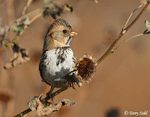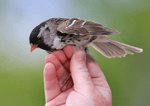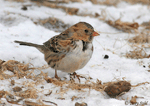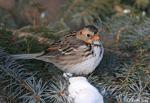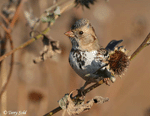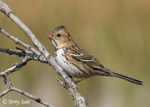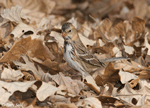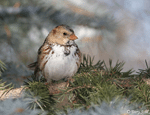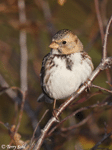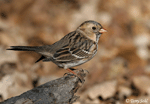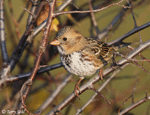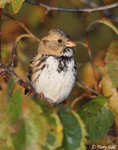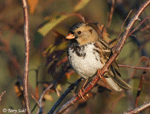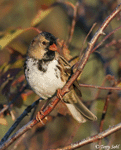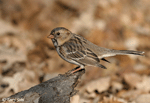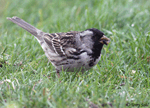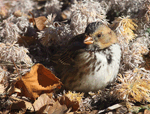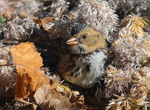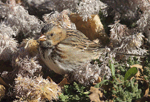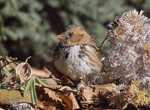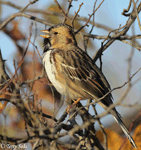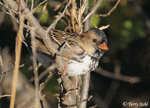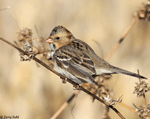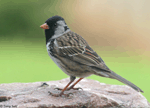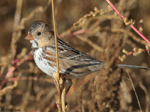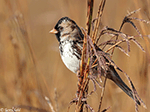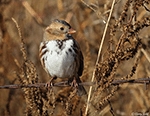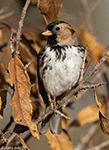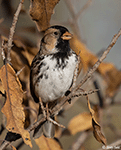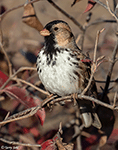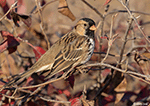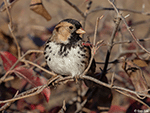| Length: 6.75 - 7.75 inches | Wingspan: 10.5 - 11.5 inches | Seasonality: Migrant / Winter |
| ID Keys: Distinctive, with black crown, face, and bib, pinkish bill, large size for a sparrow | ||
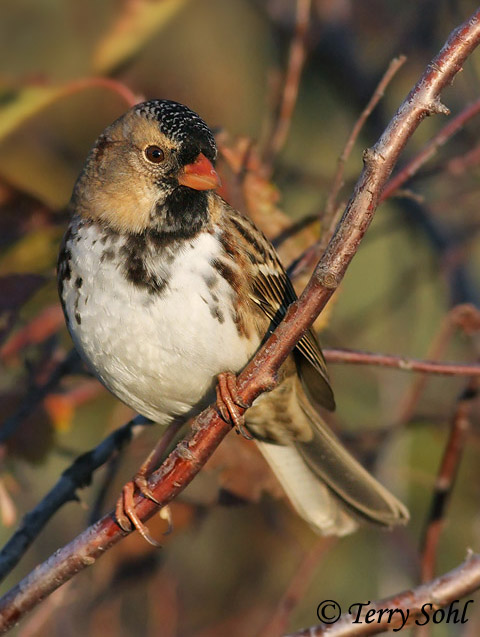 Harris's
Sparrows are a very large, beautifully plumaged sparrow species found only in
the interior of North America. They were one of the last North American
birds to have their nesting location discovered, when nesting Harris's Sparrows
were finally seen in the stunted scrubby spruces near the treeline in northern
Canada in 1931. They are the only songbird in North America that
exclusively breeds within the borders of Canada. They have adapted well to a human presence in North America,
and can often be seen on the ground in urban areas, utilizing bird feeders as
well as landscaped habitats.
Harris's
Sparrows are a very large, beautifully plumaged sparrow species found only in
the interior of North America. They were one of the last North American
birds to have their nesting location discovered, when nesting Harris's Sparrows
were finally seen in the stunted scrubby spruces near the treeline in northern
Canada in 1931. They are the only songbird in North America that
exclusively breeds within the borders of Canada. They have adapted well to a human presence in North America,
and can often be seen on the ground in urban areas, utilizing bird feeders as
well as landscaped habitats.
Habitat:
Open woods, brush, shelterbelts, residential areas. In their breeding range in Canda, they are most often found in boreal forest near the treeline, where evergreen trees are stunted.
Diet:
Mostly seeds, insects, berries. Varies with season, may include more seeds and berries in winter, insects in the summer.
Behavior:
Primarily forages along the ground, often scratching through leaf litter in search of food. Will also forage through low vegetation.
Nesting:
Non-Breeder in South Dakota. In their Canadian breeding habitat, the nest is a cup built of twigs, mosses, and lichens, usually placed on the ground under vegetative cover. The female usually lays between 3 and 5 eggs, and she alone incubates them. When the eggs hatch, both parents help to feed the young. The young leave the nest after about 10 days.
Song:
Repeated clear tremulous whistles in 1 pitch, sometimes followed at an interval by several clear notes in another pitch. Calls sound like a loud metallic spink and a drawn-out tseep.
- Click here to hear the song of a Harris's Sparrow1
- Click here to hear the short call notes of a Harris's Sparrow2
Migration:
Winters in central to southern Great Plains, summers in remote north-central Canada. In South Dakota they are common migrants, especially in the eastern half of the state. Some birds may occasionally overwinter in the far southern part of South Dakota.
Interactive eBird Map:
Click here to access an interactive eBird map of Harris's Sparrow sightings
Similar Species:
Generally distinctive, not easily confused with other sparrow species. Their large size, chunky body, plumage patterns, and bill are quite different than any other sparrow species that is found in South Dakota.
Bird Feeders:
Harris's Sparrows will attend feeder areas for grains, mixed birdseed, suet, or breadcrumbs. Note Harris's Sparrows typically feed by foraging on the ground, so presentation matters. They will feed directly on a platform feeder. However, for many "typical" feeders they will feed on fallen seeds below the feeder, rather than feed directly from the feeder itself.
Conservation Status:
Harris's Sparrows have undergone a slight population decrease in recent decades. Habitat loss and climate change are likely cuases. However, they are still found across a broad geographic area and are relatively common in many parts of their range. The IUCN lists the Harris's Sparrow as a species of "Least Concern".
Further Information:
Photo Information:
October 8th, 2008 - Minnehaha County, South Dakota - Terry Sohl
Additional Photos:
Click on the image chips or text links below for additional, higher-resolution Harris's Sparrow photos.
Audio File Credits:
- 1Ian Cruickshank. Recorded in British Columbia, Canada on April 6th, 2014. Original recording and information from xeno-canto.
- 2Paul Marvin. Recorded in Saunders County, Nebraska on October 10th, 2014. Original recording and information from xeno-canto.
| Click on the map below for a higher-resolution view |
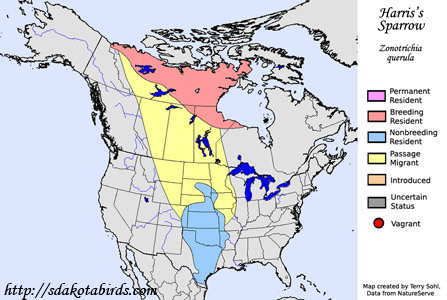 |
| South Dakota Status: Common migrant in the eastern part of the state, uncommon in the west. Rare in winter, primarily in the southern part of the state. |
Additional Harris's Sparrow Photos
Click for a higher-resolution version of these photos
